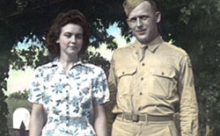War Stories
Adapted from the booklet "Being A Joines: A Life in the Brushy Mountains" written by Daniel Patterson, Joyce Joines Newman, Allen E. Tullos, and Tom Davenport, and published in 1981 by the Curriculum in Folklore of the University of North Carolina at Chapel Hill. Adapted and revised in 2004.
All his life Mr. Joines continued as a matter of course to turn daily incidents into comic anecdotes and to pick up jokes and stories from newspapers, magazines, and other people. But he told these newer materials less often and consequently they did not as often attain a fully polished form. The war in fact marked the beginning of the end of many activities that had fostered his early story telling. Although Mr. Joines continued to hunt for many years after the war, he now hunted coons rather than foxes, so he went with one or two men, following the dogs, rather than sitting around a fire listening to the dogs and spinning yarns. It was still natural to compete in telling tall tales as they hunted, but Mr. Joines probably heard fewer fresh lies. Many other activities where stories had been told were now a thing of the past. The community had ceased to gather for corn shuckings and molasses makings because people left farm work for town and factory jobs. Mr. Joines was now a married man with children and had less time for telling tales in male gatherings and less interest in doing so. Radio and motion pictures, and soon television, provided entertainment for family evenings.
Mr. Joines's war experiences, however, had excited him to add new stories to his repertory, and these were the tales that his children most begged to hear. Unlike the earlier ones, all these stories are personal narratives. Since they take place in a world completely outside the experience of his audience, he usually told them in the midst of descriptive accounts of war conditions. Some of the accounts--as when he told how drunken officers partied while wounded men waited for admission to a hospital--tend only slightly toward story. That is, while they use occasional dialogue, they focus more on conditions than on actions, on groups of people more than on a central character. But a number of the stories are carefully wrought set pieces that have character, actions, dialogue, and punch lines. The model underlying them is that of the comic "true" local character anecdote. A good example is Mr. Joines's story of zipping around a tree four times before his buddy could jump from his jeep to the ground. Mr. Joines's motivation was so purely artistic in this story that he altogether omitted mention of the arrival of the American troops who rescued his unit from German gunfire. He wanted to end the tale with the punch line, "'Doc, don't need to tell me you can't move,’ said, ‘I saw him come around that oak tree four times before I hit the ground.'"
Funny or serious, a number of the war stories and accounts used in the film deal with the callousness or incompetence of officers. Of General Patton, under whom he served, Mr. Joines said, "if he could have took ten men and waited three days and done a job, he'd rather have a thousand and lose half of them and do it today." The nickname Old Blood and Guts meant "Patton’s guts and our blood." (FT 366/367) Mr. Joines had grown up in an egalitarian world. As he said, "It didn’t give us no inferiority complex when we got out among other people. Why, we felt as big as they did. We knowed one thing. They might read better'n we could. They might dress better'n we could. They might have finer things 'bout their home and everything than we could. But we could lick any one of 'em that put a foot on the ground." (Newman, 1974: 40) So one of the hardest things he had to learn was to take orders. The issue is implied not only in stories used in the film but also, Joyce Newman points out, in many of his other war stories, even some about taking care of children, another important theme in both his war stories and his photographs. One story, for example, tells of his feeding hungry children his own dinner, despite orders not to do so, under threat of a court martial.
Most of the greater horrors of the war he simply described rather than cast into tale form. Usually he was not a participant in these, but an observer after the event: boxcar after boxcar that the Germans had packed with people standing and burning in unslaked lime, or hundreds of children whose hands had been blown off when they tried to pick up pretty "butterfly bombs" dropped from German airplanes, or three miles of road where the Germans had "lined up 66,000 Poles and Jews and shot their brains out . . . with machine guns and rifles." Or the atrocities committed by the Americans after seeing these things: "there came a whiteness over every one of the boys, they's all laughing, joking, something going on, teasing one another, but they'd get quiet. And everything that moved for two or three days, it didn't make no difference, they didn't wait to see whether it was a kid, woman, man, or what, they shot it." (FT366/367)
Unpublished Sources:
Newman, Joyce Joines. 1974. "Invoking and Subduing the Irrational: Narrator, Repertory, Style, and Social Context of Tales from Western North Carolina." Graduate term paper, 42 pp. (Southern Folklife Collection, Library of theUniversity of North Carolina at Chapel Hill.) FT366/367. Field tapes, Southern Folklife Collection, Library of theUniversity of North Carolina at Chapel Hill.
